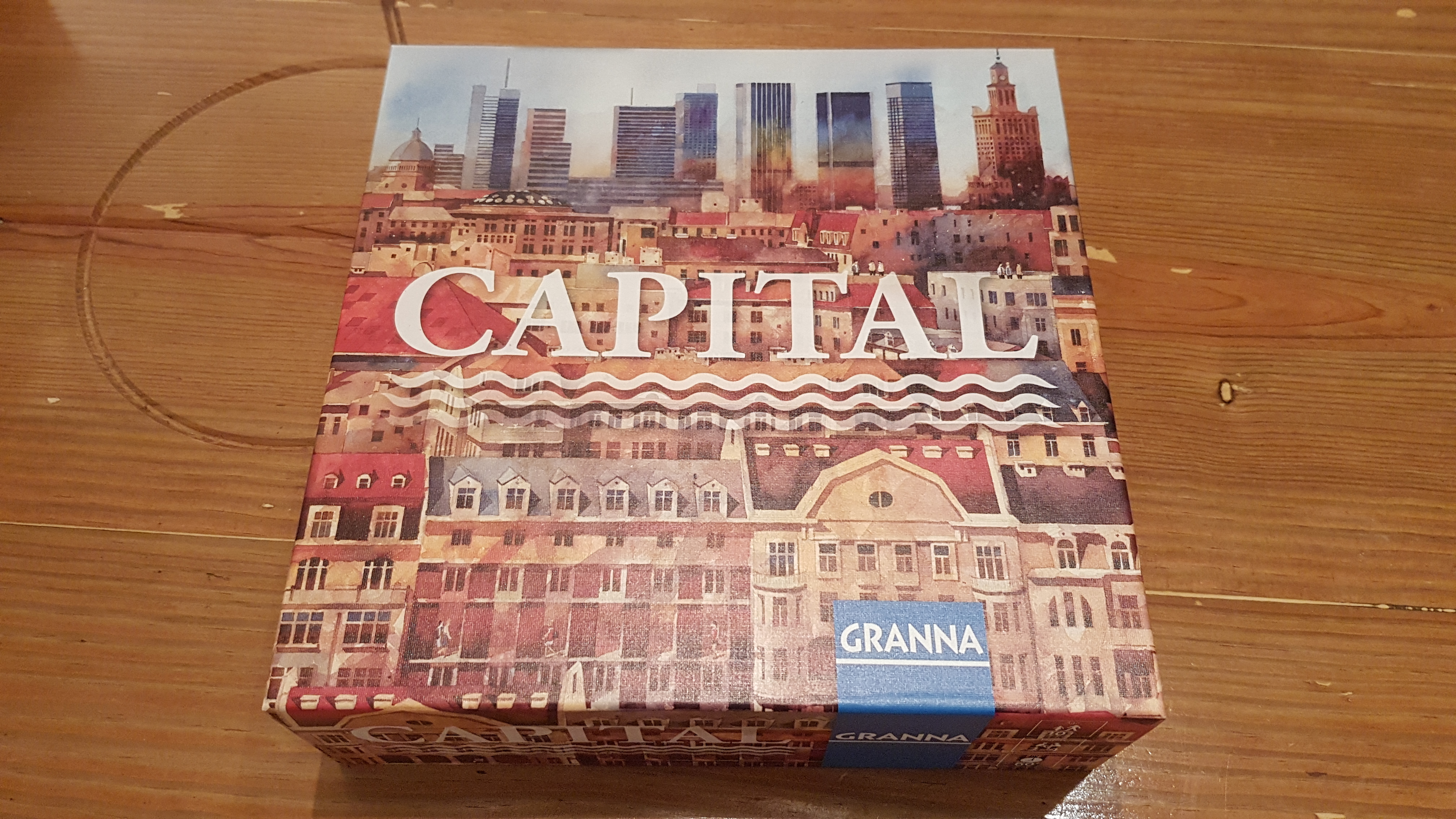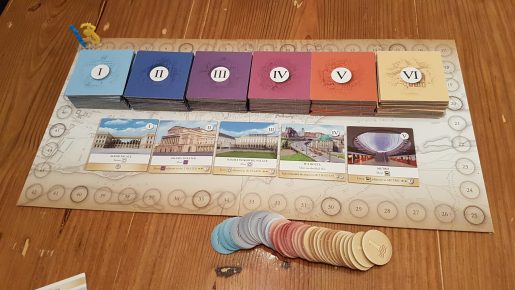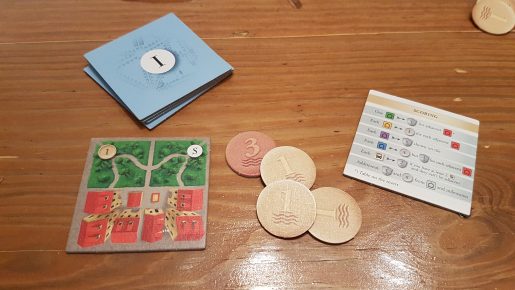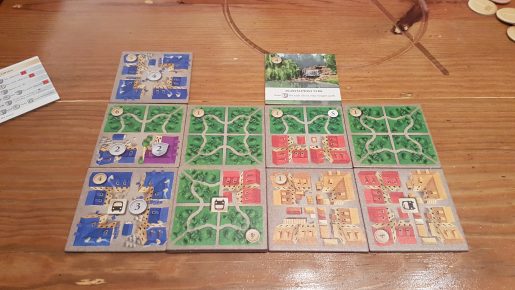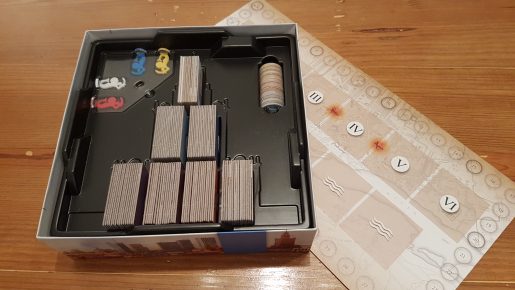Capital, also called Warsaw: City of Ruins, is a city building board game from 2016, with tile placement and drafting mechanics. From publisher Granna and designer Filip Miłuński, the game sees 2 – 4 players spend around 45 minutes constructing a zone of Poland’s capital Warsaw. With residential areas, parks and cultural sections to be built, and two World Wars to survive through, the game thematically draws from history. However, is this a board game that will be remembered in the history books? Let’s find out!
Players start off with a basic title split down the middle into residential and park areas, each made up of 2 squares. This is important as each standard tile is made up of four squares, that can be different types. Each player also gains 6 starting coins from the reserve and the game is ready to begin. A game of Capital is played out over 6 rounds, or epochs, with 5 milestones between them.
At the start of a round someone takes the pile of tiles for the round, indicated via roman numerals, shuffles them and deals 4 to each player. These can be standard tiles with types of areas or public buildings that offer bonus was of scoring. Either way each tile comes with a coin cost and players will simultaneously be picking one from their hand. By paying the cost players can add the tile into their grid, which has a size limit of 4 x 3 tiles. Note that the 4 x 3 grid can be either portrait or landscape in orientation.
Tiles must either be played adjacent to already placed tiles or on top of existing tiles. This latter option is referred to as overbuilding, and allows the player to subtract the cost of the covered tile from the cost of the new tile. If a player doesn’t want any of the tiles, or cannot afford one they want, player can discard a tile back into the box and gain 3 coins. Once a tile has been chosen, or discarded, the player passes the rest of the tiles in their hand to the next player. Looking at the tiles passed to you the process is repeated until no tiles are passed on.
At the end of each epoch a milestone is reached, with a bonus milestone title being awarded for free to whomever has best satisfied its condition, of having the most or least of a specific area type for example. Income in terms of points and coins are then determined. A handy scoring guide tile is included in the box to somewhat speed up this process, a component which is almost essential for the first couple of games.
Based on their colour, which indicates the type of area, players work down the list on the guide. For example, only one green Park per player is scored gaining a victory point for separate adjacent red residential areas. Blue Industrial areas on the other hand reward the player the number of coins indicated on them but lose a victory point per adjacent residential area. Public buildings are also now scored, or their effects taken into account. At the end of the sixth epoch the game is over and whomever has the most points wins.
The only exceptions to this scoring phase are epochs III and IV, thematically when World War I and II occur. Before awarding the milestone or earnt income, a war phase occurs, seeing a number of tiles returned to the box from players districts equal the the World War number. This creates an interesting dynamic which often isn’t picked up during the first game, where players will want to buy a tile they don’t want in order to not lose a good tile during war. While it seems like it could be annoying, if you plan for it can issues be avoided. There are also two full rounds following this where tiles aren’t removed. The only issue with the wars is that it is easy to forget them, with only two small symbols on the tile board. A couple of tokens to put on the milestones would have been much better reminders.
The special buildings make the game of Capital what it is, offering different point and coin scoring opportunities. However, unless playing the game only with two players you’ll see all of the included tiles with a game or two, certainly the case for a 4 player game when all will be dealt out. For some additional variety it would have been great if either more had been included or these were double sided like the milestones tiles.
In a similar way to Carcassonne, but on a limited sized grid, the standard tiles of Capital add together to create a colourful, growing city. Alas, the public building tiles abruptly break the visual appearance, not even remotely fitting the art design of the rest of the tiles. This is 100% a visual issue, and not gameplay related, so some will suggest it is less important. Still, it is an odd design decision to have side view drawings of buildings, regardless of them being real world buildings, as they stick out like a sore thumb from the otherwise top down city view.
On the whole, the rulebook does a good job of explaining the terms and mechanics of the title. Nevertheless, there are a couple of rule ambiguities not covered in the rules, such as if you have to build milestones, as you are not forced to build any other tile type. On top of this, for the first few games it’ll be best to keep the rulebook in reaching distance. In early games, each time a public building is dealt out players have to clarify what exactly it offers. This does ebb away over multiple plays though, and the iconography after this point makes logical sense. It’s just the need for multiple plays to make them readable that is somewhat discouraging for new players.
Unusually the rulebook is full of as many facts as rules, with tidbits of information about the city of Warsaw and the many unique public buildings that can be constructed throughout the game. This makes the rulebook look more daunting than it should, due to the size, with the gameplay neatly stepped through. The only thing missing is an image of setup, as this would help players in the initial game. Diagrams are there though for all the important aspects, such as placement and scoring.
The war epochs are certainly an interesting twist from the normal tile placement formula, that makes Capital somewhat unique. Initially, the scoring between rounds substantially slowed the pace of the gameplay down, though this thankfully dropped after a few plays. This is one of the features that makes Capital not that great as a gateway title but one that can provide a great next step from the humble Carcassonne. The artstyle is a bit of a mixed bag, something that doesn’t help the game garner player interest. However, for the choices on offer the game is certainly not one to just discard for coins.
[Editor’s Note: Capital was provided to us by Coiledspring Games for the review.]

